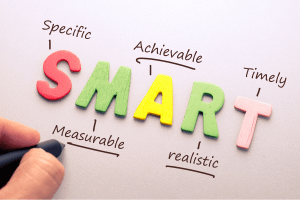September is Self-Improvement Month, the idea that we can better ourselves and our lives through awareness and intentional effort. This blog provides five tips for building your self-improvement skills. The tips can be implemented in any order, and you can pick and choose which ones you want to try. We recommend implementing tip number one first, though, as it makes all the other tips easier and comes from a place of self-compassion.
1. Start With Awareness and Compassion
We can't begin to change anything about ourselves if we don't know where we're starting from. Building up your self-awareness gives you the starting point from which you can begin to mindfully make positive changes in your life.
When building this awareness, it can be helpful to remember RAIN, a method of mindfulness and self-compassion popularized by Tara Brach in her books Radical Acceptance and Radical Compassion.
Here's what R.A.I.N. stands for:
- R - Recognize what's going on
- A - Allow the feelings/situation to be
- I - Investigate with kindness and curiosity
- N - Nurture/natural loving awareness
So, how might this look in terms of self-improvement? Maybe you're thinking that you sit down too much of the day. It can be so easy to get down on ourselves about our current state, but RAIN steps in before you can be unkind to yourself (and puts a stop to negative self-talk).
 R asks you to simply recognize what is going on and where you're starting from—ok, I sit too much.
R asks you to simply recognize what is going on and where you're starting from—ok, I sit too much.
A asks that you allow this situation to exist. This means that you don't judge yourself for the situation or feeling; you just allow it to be.
I asks that you investigate a little bit. Why do you sit so much? How do you feel when you sit, or what limiting self (or work) beliefs do you have about your sitting and standing abilities?
N pulls it back around to compassion and nurturing. Instead of saying you're "not good enough" because you sit, say, "Ok, I sit a bit too much... but I am not a flawed person because of this."
This practice of compassion gives you a gentle starting point from which you can change your behaviors.
RAIN is also a wonderful method to pull in during times of anxiety or stress, depression, or challenging times of life like experiencing illness.
2. Build Up Small Habits
“We are what we repeatedly do. Excellence, then, is not an act, but a habit.” —Not Aristotle, but still an excellent sentiment.
Whether we realize it or not, habits make up our lives. Whether it's how we study, what we eat for dinner, if we work out or sit in front of the television, or even just the order in which we get ready in the morning—habits guide our choices. Habits are those things we do without having to think about them, like breathing or brushing your teeth. Building habits, though, requires some thought in the beginning, like getting yourself to floss. Breaking habits, too, requires a lot of work.
These titles study the science and psychology behind habit building and breaking, simplifying tough behavioral concepts and giving you clear steps to help you find your best self.
Beyond reading about habit building and breaking, some people find it effective to track their habits. Tracking provides a slight reward system, activating dopamine whenever you check off your habit or give yourself a gold star, which motivates you to continue your habit.
To get started habit tracking, you might consider a minimalist printable, particularly if pen-to-paper is motivating for you. If you're into statistics and graphs, there are many apps available for Android and iOS devices. Some apps, like Habitify, are minimalist and clean, while others, like Habit Bull, let you see your trends from any angle. Habitica, another option, gamifies the process of habit building and breaking by having you create a digital character that you outfit and fight bad guys with.
3. Redefine Your Goals With S.M.A.R.T., S.U.C.C.E.S.S., or the 5 Whys
This tip works well for building habits, but you can use it for any goal.
S.M.A.R.T. Goals
Built for the business world in 1981, S.M.A.R.T. is a way of setting up your goals so that you can be sure of when you have achieved them. It removes ambiguity by asking you to define specific attributes about your goal.
A S.M.A.R.T. goal should be:

- Specific
- Measurable
- Achievable/attainable
- Realistic
- Time-bound
A vague example of a goal might be: "I want to lose weight."
You can make this goal S.M.A.R.T. by defining it a little further: "I want to lose 5 pounds in the next month."
The second goal is S.M.A.R.T. because it is:
- Specific - 5 pounds in a month
- Measurable - measured by pounds
- Achievable/attainable - a healthy weight loss is 1-2 lbs per week, so this goal is within a healthy and attainable range
- Realistic - similar to attainable, it is something that you could realistically achieve
- Time-bound - we are limiting our time for this goal to one month
S.U.C.C.E.S.S. Goals
Sometimes a S.M.A.R.T. goal feels a bit... business-y. This is where S.U.C.C.E.S.S. goals come in. Designed for personal goals, S.U.C.C.E.S.S. goals are:
- Subjective - they reflect what you personally want, not what others want for you
- Urgent - there are benefits to acting now, versus waiting
- Committed - persistence is key. These goals are things you can persist on until you achieve them.
- Concrete - these goals are specific, much like a S.M.A.R.T. goal
- Evaluated - you'll want to regularly review your progress
- Shared - writing down or publicizing your goals increases your accountability
- Supported - goals that have support from others are more likely to succeed
Looking back at our vague goal of "I want to lose weight," our S.U.C.C.E.S.S. goal might be, "I want to lose weight because I want to get healthy for my family, and I need to get a handle on my blood pressure. I am going to share my goal with my friends so they can support me on my journey. I will weigh in every Wednesday. I will aim to lose 1-2 pounds per week."
This goal is S.U.C.C.E.S.S.ful because it is:
- Subjective - this goal matters because they want to get healthy for their family
- Urgent - their current health situation, their blood pressure, leads to a sense of urgency (but you don't need to wait for things to be unhealthy to start self-improvement—with awareness, or tip number one, you can start where you are)
- Committed - this is personal, but the person's persistence can help them achieve their goal
- Concrete - they are sticking to the healthy 1-2 pounds a week range, which is a specific amount that they can measure and review
- Evaluated - they are measuring their weight every Wednesday, which allows them to evaluate their progress
- Shared - they are sharing their goal with their friends
- Support - their friends and family will support their goal
5 Whys
The 5 Whys technique can help with either S.M.A.R.T. or S.U.C.C.E.S.S. goals or function on its own. The idea is simple—examine your goal by asking yourself, "Why?" five times in a row. Sometimes you may find that you don't need all five whys to find your true motivation. Here's an example:
"I want to lose weight."
- Why? - I want to lower my blood pressure.
- Why? - I want to be healthier.
- Why? - I want to live a long life with my family.
- Why? - My family is the most important thing in my life.
- Why? - They love me unconditionally, and I love them unconditionally.
So, your 5 Whys goal might be: "I want to lose weight so that I can live a long life with my family, who love me unconditionally, and because I love them unconditionally."
4. Start a Gratitude Practice
Gratitude—expressing it, appreciating it, or acknowledging it—has tremendous mental health benefits: it can help people feel more positive emotions, deal with adversity, and cultivate or maintain a hopeful attitude. Gratitude is a practice you can develop with simple exercises like meditation, journaling, thank-you notes, and more. Here are a few methods of fostering gratitude that you can try. 
Time-based Journaling Exercise
Set a timer for some time between two and five minutes. In that time, make a list or write sentences of things you are grateful for. Allow your pen to move across the page (or fingers across your keyboard) the entire time, and withhold self-judgement. This exercise encourages you to think outside the box and find new things to be grateful for.
Three Things a Day
For this simple but powerful exercise, jot down three things each day that you are grateful for. This can be on any piece of paper, or you can collect them in a notebook or journal to look back on.
A Month of Gratitude
Similar to three things a day, but includes keeping up the momentum of your practice. In a notebook or journal, number the lines on the side of the page from one to 30 (or 31, depending on the month). Then, as each day passes, fill out the line next to the date with a little bit of gratitude, and by the end of the month, you have a whole page of things to be grateful for.
5. Learn Something New
The Canton Public Library is your place to connect with self-improvement opportunities, and we have a plethora of ways for you to learn something new online.
GetSetUp
Geared toward seniors, these drop-in classes offer everything to keep you mentally, physically, and socially active. Classes include using technology like iPhones and Zoom, finding movement with Tai Chi or music, cooking healthy meals, and even having difficult or important conversations. Use code MICHIGANHEALTH if prompted.
Creativebug
Creativebug offers more than 1,000 award-winning art and craft videos that are available on demand. Taught by recognized design experts and artists, these classes allow you to follow along and craft your own project as you watch.


Add a comment to: 5 Self-Improvement Strategies to Implement This Fall